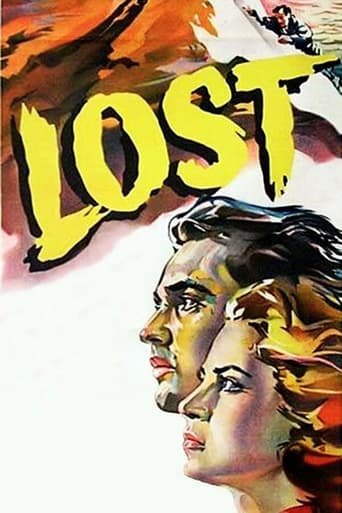Leofwine_draca
LOST is an interesting, unusually-plotted crime film to come out of Britain in 1956. The electric opening sequence has a nanny taking the baby in her care to the park. She pops into a shop and comes back outside to discover that both baby and pram are missing. So begins a race-against-the-clock investigation as a dogged detective and the missing baby's parents do their very best to follow the clues and attempt to discover just what has happened to the baby. LOST is one of those films that provides a neat snapshot of everyday life during the era, with an endless array of characters introduced and subsequently questioned as the running time goes on. The suspense builds effectively to an action climax, then a twist, and another climax even more exciting. Overall, it's a nicely made little movie, one with plenty of spirit, and an exceptional number of familiar faces in supporting roles, from Thora Hird to CARRY ON stars Joan Sims and Barbara Windsor and plenty more besides.
James Hitchcock
In Britain, as in America, there seemed to be an unwritten convention in the fifties that certain film genres were more suited to colour and others to black-and-white, and crime dramas fell firmly into the latter category. This was true both of films directly influenced by the American film noir tradition, such as "The Man Between", "The Long Memory" and "Tread Softly Stranger", and of other British crime dramas of the era such as "The Blue Lamp","Town on Trial" and "Stage Fright", Hitchcock's only British film of the decade. "Lost", however, is one of the exceptions, being made in vivid Technicolor, possibly because it is not primarily a film noir or a suspense thriller but a police procedural. Simon, the infant son of Lee Cochrane, an American diplomat, and his Austrian-born fashion designer wife Sue, is kidnapped when his nanny leaves him in his pram outside a London shop. (Younger people may find this hard to believe, but in the fifties and sixties it was common practice for mothers and others having charge of young children to leave them outside in their prams while they were shopping). Detective Inspector Craig of Scotland Yard is charged with investigating the crime. With his aquiline features, David Farrar would have made an excellent Sherlock Holmes, and he plays the patient, methodical, unemotional Craig very much as a detective of the Holmes school. He is a far cry from the rough, tough, Dirty Harry types we have become used to ever since the sixties. His method of solving the crime is to examine all the discarded items- a button from an expensive coat, a paper bag from a baker's shop in Slough, a torn page from a library book- which he finds in the vicinity of Simon's pram in Hyde Park and to trace them back to their source with the help of the Yard's forensic department. His colleagues- and Simon's distraught parents- are sceptical about this methodology, but Craig is vindicated when one of these objects does indeed prove to be the vital clue. The other cast member who stand out is the lovely Julia Arnall as Sue. Julia (who like her character was Austrian by birth) was one of the most beautiful actresses the British film industry during this period, with the looks of another Grace Kelly, but never seemed to become a major star. In Britain, as in Hollywood, looks alone have never been a cast- iron guarantee of stardom. I said earlier that this is not primarily a suspense thriller, but the final scene, a literal cliffhanger set on Beachy Head near Eastbourne, is clearly influenced by Hitchcock. (Similarly, "Town on Trial" also has a very Hitchcockian finale, in that case set on a church steeple). It is not, however, a film which one would watch today for thrills. If one watches it at all- and I can appreciate that to some modern film fans it would seem very slow and dated- it is for its historic interest as an example of an old-fashioned type of crime drama and as a nostalgic view of the now-vanished Britain of the fifties. 6/10 A goof. Craig states that an abduction can only legally be called a "kidnapping" when it is followed by a demand for money with menaces. This is not true today and was not true in 1956. In English common law, kidnapping is the unlawful taking away or transportation of a person against that person's will, whether or not a demand for money with menaces is made. The making of such a demand constitutes the separate offence of blackmail.
jimsimpson
Well acted and directed, this is a highly enjoyable mystery about the abduction of a baby in Central London. Much of the movie is shot on location giving a fascinating look at the city in the mid fifties. Julia Arnall is outstanding as the distraught mother and one wonders why Rank dropped her contract after one subsequent film. Future stars Shirley Anne Field, Barbara Windsor and Joan Sims all have bits while there are cameos from stalwarts like Thora Hird, Marjorie Rhodes, Joan Hickson, Everley Gregg and a lovely supporting performance from Eleanor Summerfield as a policewoman.
joshea98
Filmed in color, this film, which is concerned with the hunt for a baby snatched from its pram in a London street, is replete with well-known British character actors of the 1950's including Joan Sims, Eleanor Summerfield, Joan Hickson, Thora Hird and Marjorie Rhodes. It represents a marvelous look at London and its people as they were in the 1950's and is sure to evoke many memories for those who lived there at that time. Highly recommended.


